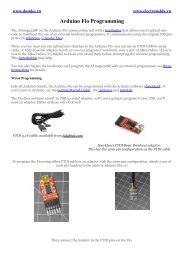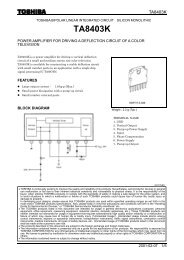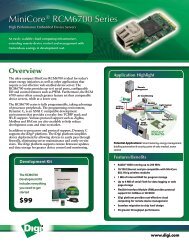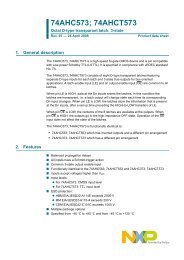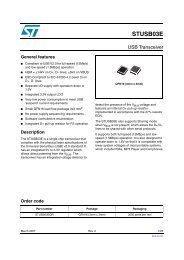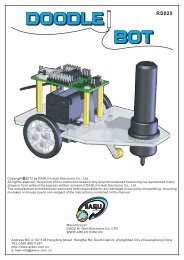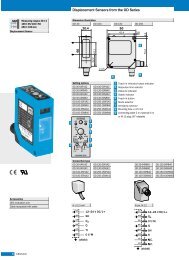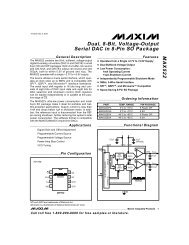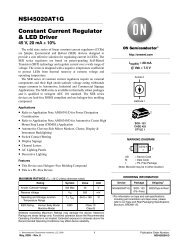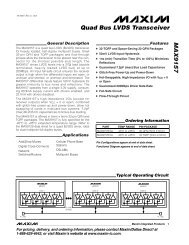DS1023 8-Bit Programmable Timing Element - IceCube
DS1023 8-Bit Programmable Timing Element - IceCube
DS1023 8-Bit Programmable Timing Element - IceCube
You also want an ePaper? Increase the reach of your titles
YUMPU automatically turns print PDFs into web optimized ePapers that Google loves.
<strong>DS1023</strong><br />
8-<strong>Bit</strong> <strong>Programmable</strong> <strong>Timing</strong> <strong>Element</strong><br />
www.maxim-ic.com<br />
FEATURES<br />
Step sizes of 0.25 ns, 0.5 ns, 1 ns, 2 ns, 5 ns<br />
On-chip reference delay<br />
Configurable as delay line, pulse width<br />
modulator, or free-running oscillator<br />
Can delay clocks by a full period or more<br />
Guaranteed monotonicity<br />
Parallel or serial programming<br />
Single 5V supply<br />
16-pin DIP or SOIC package<br />
PIN ASSIGNMENT<br />
IN<br />
LE<br />
Q/P0<br />
CLK/P1<br />
D/P2<br />
P3<br />
P4<br />
GND<br />
1<br />
2<br />
3<br />
4<br />
5<br />
6<br />
7<br />
8<br />
16<br />
15<br />
14<br />
13<br />
12<br />
11<br />
10<br />
9<br />
<strong>DS1023</strong> 300-mil DIP<br />
<strong>DS1023</strong>S 300-mil SOIC<br />
V CC<br />
OUT/OUT<br />
P/S<br />
P7<br />
P6<br />
MS<br />
P5<br />
REF/PWM<br />
PIN DESCRIPTION<br />
IN<br />
P0/Q<br />
P1/CLK<br />
P2/D<br />
P3 - P7<br />
GND<br />
OUT/ OUT<br />
REF/PWM<br />
P /S<br />
MS<br />
LE<br />
V CC<br />
- Input<br />
- Parallel Input P0 (parallel mode)<br />
- Serial Data Output (serial mode)<br />
- Parallel Input P1 (parallel mode)<br />
- Serial Input Clock (serial mode)<br />
- Parallel Input P2 (parallel mode)<br />
- Serial Data Input (serial mode)<br />
- Remaining Parallel Inputs<br />
- Ground<br />
- Output<br />
- Reference or PWM Output<br />
- Parallel / Serial Programming<br />
Select<br />
- Output Mode Select<br />
- Input Latch Enable<br />
- Supply Voltage<br />
DESCRIPTION<br />
The <strong>DS1023</strong> is an 8-bit programmable delay line similar in function to the DS1020/DS1021.<br />
Additional features have been added to extend the range of applications:<br />
The internal delay line architecture has been revised to allow clock signals to be delayed by up to a full<br />
period or more. Combined with an on-chip reference delay (to offset the inherent or “step zero” delay of<br />
the device) clock phase can now be varied over the full 0-360 degree range.<br />
1 of 16 101001
2 of 16<br />
<strong>DS1023</strong><br />
On-chip gating is provided to allow the device to provide a pulse width modulated output, triggered by<br />
the input with duration set by the programmed value.<br />
Alternatively the output signal may be inverted on chip, allowing the device to perform as a free-running<br />
oscillator if the output is (externally) connected to the input.<br />
PROGRAMMING<br />
The device programming is identical to the DS1020/DS1021. Note, however, that the serial clock and<br />
data pins are shared with three of the parallel input pins.<br />
The P /S pin controls the same function as “Mode Select” on the DS1020/DS1021 (but with reversed<br />
polarity). A low logic level on this pin enables the parallel programming mode. LE must be at a high<br />
logic level to alter the programmed value; when LE is taken low the data is latched internally and the<br />
parallel data inputs may be altered without affecting the programmed value. This is useful for<br />
multiplexed bus applications. For hard-wired applications LE should be tied to a high logic level.<br />
When P /S is high serial programming is enabled. LE must be held high to enable loading or reading of<br />
the internal register, during which time the delay is determined by the previously programmed value.<br />
Data is clocked in MSB to LSB order on the rising edge of the CLK input. Data transfer ends and the<br />
new value is activated when LE is taken low.<br />
PARALLEL MODE ( P /S = 0)<br />
In the PARALLEL programming mode, the output of the <strong>DS1023</strong> will reproduce the logic state of the<br />
input after a delay determined by the state of the eight program input pins P0 - P7. The parallel inputs<br />
can be programmed using DC levels or computer-generated data. For infrequent modification of the<br />
delay value, jumpers may be used to connect the input pins to V CC or ground. For applications requiring<br />
frequent timing adjustment, DIP switches may be used. The latch enable pin (LE) must be at a logic 1 in<br />
hardwired implementations.<br />
Maximum flexibility is obtained when the eight parallel programming bits are set using computergenerated<br />
data. When the data setup (t DSE ) and data hold (t DHE ) requirements are observed, the enable pin<br />
can be used to latch data supplied on an 8-bit bus. Latch enable must be held at a logic 1 if it is not used<br />
to latch the data. After each change in delay value, a settling time (t EDV or t PDV ) is required before input<br />
logic levels are accurately delayed.<br />
SERIAL MODE ( P /S = 1)<br />
In the SERIAL programming mode, the output of the <strong>DS1023</strong> will reproduce the logic state of the input<br />
after a delay time determined by an 8-bit value clocked into serial port D. While observing data setup<br />
(t DSC ) and data hold (t DHC ) requirements, timing data is loaded in MSB-to-LSB order by the rising edge of<br />
the serial clock (CLK). The latch enable pin (LE) must be at a logic 1 to load or read the internal 8-bit<br />
input register, during which time the delay is determined by the last value activated. Data transfer ends<br />
and the new delay value is activated when latch enable (LE) returns to a logic 0. After each change, a<br />
settling time (t EDV ) is required before the delay is accurate.<br />
As timing values are shifted into the serial data input (D), the previous contents of the 8-bit input register<br />
are shifted out of the serial output pin (Q) in MSB-to-LSB order. By connecting the serial output of one<br />
<strong>DS1023</strong> to the serial input of a second <strong>DS1023</strong>, multiple devices can be daisy-chained (cascaded) for<br />
programming purposes (Figure 1). The total number of serial bits must be eight times the number of units<br />
daisy-chained and each group of 8 bits must be sent in MSB-to-LSB order.
<strong>DS1023</strong><br />
Applications can read the setting of the <strong>DS1023</strong> Delay Line by connecting the serial output pin (Q) to the<br />
serial input (D) through a resistor with a value of 1 to 10 kohms (Figure 2). Since the read process is<br />
destructive, the resistor restores the value read and provides isolation when writing to the device. The<br />
resistor must connect the serial output (Q) of the last device to the serial input (D) of the first device of a<br />
daisy chain (Figure 1). For serial readout with automatic restoration through a resistor, the device used to<br />
write serial data must go to a high impedance state.<br />
To initiate a serial read, latch enable (LE) is taken to a logic 1 while serial clock (CLK) is at a logic 0.<br />
After a waiting time (t EQV ), bit 7 (MSB) appears on the serial output (Q). On the first rising (0 --> 1)<br />
transition of the serial clock (CLK), bit 7 (MSB) is rewritten and bit 6 appears on the output after a time<br />
t CQV . To restore the input register to its original state, this clocking process must be repeated eight times.<br />
In the case of a daisy chain, the process must be repeated eight times per package. If the value read is<br />
restored before latch enable (LE) is returned to logic 0, no settling time (t EDV ) is required and the<br />
programmed delay remains unchanged.<br />
Since the <strong>DS1023</strong> is a CMOS design, unused input pins (P3 - P7) must be connected to well-defined logic<br />
levels; they must not be allowed to float. Serial output Q/P0 should be allowed to float if unused.<br />
CASCADING MULTIPLE DEVICES (DAISY CHAIN) Figure 1<br />
SERIAL READOUT Figure 2<br />
REFERENCE DELAY<br />
In all delay lines there is an inherent, or “step zero”, delay caused by the propagation delay through the<br />
input and output buffers. In this device the step zero delay can be quite large compared to the delay step<br />
size. To simplify system design a reference delay has been included on chip which may be used to<br />
compensate for the step zero delay. In practice this means that if the device is supplied with a clock, for<br />
example, the minimum programmed output delay is effectively zero with respect to the reference delay.<br />
3 of 16
<strong>DS1023</strong><br />
For highest accuracy it is strongly recommended that the reference delay is used. Variations in input<br />
voltage levels and transition times can significantly alter the measured delay from input to output. This<br />
effect is totally removed if the reference delay output is used. Furthermore, adverse effects on step zero<br />
delay caused by process temperature coefficients are also cancelled out.<br />
INPUT PULSE DURATION<br />
The internal architecture of the <strong>DS1023</strong> allows the output delay time to be considerably longer than the<br />
input pulse width (see ac specifications). This feature is useful in many applications, in particular clock<br />
phase control where delays up to and beyond one full clock period can be achieved.<br />
MODE SELECT<br />
The <strong>DS1023</strong> has four possible output functions but only two output pins. The functionality of the two<br />
output pins is determined by the Mode Select (MS) pin.<br />
MS = 0 Figure 3<br />
Output Function Name Pin Number<br />
Reference Output REF 9<br />
Delayed Output OUT 15<br />
OUT is a copy of the input waveform that is delayed by an amount set by the programmed values (Table<br />
1). A programmed value of zero will still result in a non-zero delay as indicated in the Step Zero delay<br />
specification. The signal on OUT is the same polarity as the input.<br />
REF is a fixed reference delay. It also is a copy of the input waveform but the delay interval is fixed to a<br />
value approximately equal to the Step Zero Value of the device (as shown in the Reference Delay<br />
specification). In fact the device is trimmed to ensure that the Reference Delay is always slightly longer<br />
than the Step Zero Value (by 1.5 ns typically).<br />
4 of 16
MS = 1 Figure 4<br />
<strong>DS1023</strong><br />
Output Function Name Pin Number<br />
Pulse Width Modulated Output PWM 9<br />
Delayed and Inverted Output OUT 15<br />
PWM is an output triggered by the rising edge of the input waveform. After a time interval approximately<br />
equal to the Step Zero delay of the device the PWM output will go high. The output will return to a low<br />
level after a time interval determined by the programmed values (Table 1). Hence output pulse widths can<br />
be obtained from (nearly) zero to the full delay range of the device. In practice the minimum output pulse<br />
width is limited by the response time of the device to approximately 5ns. Programmed values less than<br />
this will result in degradation of the output high level voltage until ultimately no discernible output pulse<br />
is produced. The frequency/repetition rate of the output is determined by the input frequency. The input<br />
pulse width can be shorter than the output pulse width, and is limited only by the minimum input pulse<br />
width specification. The PWM function is not “re-triggerable”, subsequent input trigger pulses should<br />
not be present until the output has returned to a low level.<br />
OUT is an inverted copy of the input waveform that is delayed by an amount set by the programmed<br />
values (Table 1). A programmed value of zero will still result in a non-zero delay as indicated in the Step<br />
Zero delay specification. The OUT pin may also be externally connected to the input pin to produce a<br />
free-running oscillator. The frequency of oscillation is determined by the programmed delay value of the<br />
device (see Table 2).<br />
5 of 16
FUNCTIONAL BLOCK DIAGRAM Figure 5<br />
<strong>DS1023</strong><br />
DELAY LINE DETAIL (CONCEPTUAL) - <strong>DS1023</strong>-200, <strong>DS1023</strong>-500 Figure 6<br />
6 of 16
DELAY LINE DETAIL (CONCEPTUAL) - <strong>DS1023</strong>-25, <strong>DS1023</strong>-50, <strong>DS1023</strong>-100<br />
Figure 7<br />
<strong>DS1023</strong><br />
PART NUMBER TABLE Table 1<br />
DELAYS RANGES AND TOLERANCE (all times measured in ns)<br />
MAX. DELAY TIME (1)/<br />
STEP MAX. OUTPUT PULSE MAXIMUM MAXIMUM<br />
SIZE WIDTH (2) DEVIATION (3) I/P FREQ<br />
MINIMUM I/P<br />
PULSE<br />
WIDTH<br />
PART<br />
NUMBER<br />
<strong>DS1023</strong>-25 0.25 63.75 1 25 MHz 20<br />
<strong>DS1023</strong>-50 0.50 127.5 2 25 MHz 20<br />
<strong>DS1023</strong>-100 1.0 255 4 25 MHz 20<br />
<strong>DS1023</strong>-200 2.0 510 8 25 MHz 20<br />
<strong>DS1023</strong>-500 5.0 1275 20 10 MHz 50<br />
1. In “Normal” mode (MS=0). Measured with respect to REF output. The minimum delay time is zero<br />
(or less, by 1.5 ns typically)<br />
2. In PWM mode (MS=1). The minimum output pulse width for reliable operation is 5 ns; programmed<br />
values less than this may produce reduced output voltage levels or no output at all.<br />
3. This is the deviation from a straight line drawn between the step zero value and the maximum<br />
programmed delay time.<br />
OSCILLATOR CONFIGURATION Table 2<br />
PART NUMBER<br />
STEP<br />
SIZE (4)<br />
MINIMUM O/P<br />
FREQUENCY (5)<br />
MAXIMUM O/P<br />
FREQUENCY (5)<br />
<strong>DS1023</strong>-25 0.5 6.6 MHz 22 MHz<br />
<strong>DS1023</strong>-50 1.0 3.6 MHz 22 MHz<br />
<strong>DS1023</strong>-100 2.0 1.9 MHz 22 MHz<br />
<strong>DS1023</strong>-200 4.0 0.98 MHz 22 MHz<br />
<strong>DS1023</strong>-500 10.0 0.4 MHz 22 MHz<br />
4. Step size in output period (in ns).<br />
5. Maximum output frequency depends on the actual step zero delay value, worst case values are shown<br />
in the table. The output period is given by: 2 * t D where: t D = absolute delay value.<br />
7 of 16
DALLAS SEMICONDUCTOR TEST CIRCUIT Figure 8<br />
<strong>DS1023</strong><br />
TEST SETUP DESCRIPTION<br />
Figure 8 illustrates the hardware configuration used for measuring the timing parameters of the <strong>DS1023</strong>.<br />
The input waveform is produced by a precision pulse generator under software control. Time delays are<br />
measured by a time interval counter (20 ps resolution) connected to the output. The <strong>DS1023</strong> serial and<br />
parallel ports are controlled by interfaces to a central computer. All measurements are fully automated<br />
with each instrument controlled by the computer over an IEEE 488 bus.<br />
TEST CONDITIONS<br />
INPUT:<br />
Ambient Temperature:<br />
Supply Voltage (V CC ):<br />
Input Pulse:<br />
Source Impedance:<br />
Rise and Fall Time:<br />
Pulse Width:<br />
Period:<br />
25C 3C<br />
5.0V 0.1V<br />
High = 3.0V 0.1V<br />
Low = 0.0V 0.1V<br />
50 ohms max.<br />
3.0 ns max.<br />
(measured between<br />
0.6V and 2.4V)<br />
500 ns<br />
1 s<br />
NOTE: Above conditions are for test only and do not restrict the operation of the device under other data<br />
sheet conditions.<br />
OUTPUT:<br />
Output is loaded with a 74F04. Delay is measured between the 1.5V level of the rising edge of the input<br />
signal and the 1.5V level of the corresponding edge of the output.<br />
8 of 16
ABSOLUTE MAXIMUM RATINGS*<br />
Voltage on Any Pin<br />
Operating Temperature Range<br />
Storage Temperature<br />
Soldering Temperature<br />
Short Circuit Output Current<br />
-1.0V to +7.0V<br />
0C to 70C<br />
-55C to +125C<br />
260C for 10 seconds<br />
50 mA for 1 second<br />
<strong>DS1023</strong><br />
* This is a stress rating only and functional operation of the device at these or any other conditions above<br />
those indicated in the operation sections of this specification is not implied. Exposure to absolute<br />
maximum rating conditions for extended periods of time may affect reliability.<br />
DC ELECTRICAL CHARACTERISTICS (0°C to 70°C; V CC = 5V ± 5%)<br />
PARAMETER SYMBOL MIN TYP MAX UNITS NOTES<br />
Supply Voltage V CC 4.75 5 5.25 V<br />
High Level Input Voltage V IH 2 V CC +0.5 V<br />
Low Level Input Voltage V IL -0.5 0.8 V<br />
Input Leakage Current<br />
(0
TIMING DIAGRAM: SILICON DELAY LINE Figure 9<br />
<strong>DS1023</strong><br />
AC ELECTRICAL CHARACTERISTICS -<br />
<strong>DS1023</strong>-25 Delay Specifications (T A = 0C to 70C; V CC = 5V 5%)<br />
PARAMETER SYMBOL MIN TYP MAX UNITS NOTES<br />
Step Zero Delay<br />
-absolute<br />
-wrt REF<br />
t D0<br />
t DREF0 -2<br />
16.5<br />
-1.5<br />
22<br />
0<br />
ns<br />
ns<br />
1, 13<br />
2, 14<br />
Reference Delay t REF 18 22 ns 3, 13<br />
Delay Step Size t STEP 0 0.25 0.75 ns 4<br />
Maximum Delay<br />
-absolute<br />
-wrt REF<br />
t DMAX 75 80 89 ns 5, 13<br />
t DREF 60 63.75 67.5 ns 6, 14<br />
-1 +1 ns 15<br />
Delay Matching, Rising Edge<br />
to Falling Edge<br />
Integral Non-linearity<br />
(deviation from straight line) t err -1 0 +1 ns 7<br />
OUT Delta Delay t INV0 0 1 2 ns 8<br />
IN High to PWM High t PWM0 16.5 22 ns 9, 13<br />
Minimum PWM Output<br />
Pulse Width t PWM 5 ns 10<br />
Minimum Input Pulse Width t WI 20 ns 11<br />
Minimum Input Period 40 ns 12<br />
Input Rise and Fall Times t r , t f 0 1 s 16<br />
10 of 16
<strong>DS1023</strong><br />
AC ELECTRICAL CHARACTERISTICS –<br />
<strong>DS1023</strong>-50 Delay Specifications (T A = 0C to 70C; V CC = 5V 5%)<br />
PARAMETER SYMBOL MIN TYP MAX UNITS NOTES<br />
Step Zero Delay<br />
-absolute<br />
-wrt REF<br />
t D0<br />
t DREF0 -2<br />
16.5<br />
-1.5<br />
22<br />
0<br />
ns<br />
ns<br />
1, 13<br />
2, 14<br />
Reference Delay t REF 18 22 ns 3, 13<br />
Delay Step Size t STEP 0 0.5 1.5 ns 4<br />
Maximum Delay<br />
-absolute<br />
-wrt REF<br />
t DMAX 139 144 154 ns 5, 13<br />
t DREF 123 127.5 132 ns 6, 14<br />
-1 +1 ns 15<br />
Delay Matching, Rising Edge<br />
to Falling Edge<br />
Integral Non-linearity<br />
(deviation from straight line) t err -2 0 +2 ns 7<br />
OUT Delta Delay t INV0 0 1 2 ns 8<br />
IN High to PWM High t PWM0 16.5 22 ns 9, 13<br />
Minimum PWM Output<br />
Pulse Width t PWM 5 ns 10<br />
Minimum Input Pulse Width t WI 20 ns 11<br />
Minimum Input Period 40 ns 12<br />
Input Rise and Fall Times t r , t f 0 1 s 16<br />
AC ELECTRICAL CHARACTERISTICS –<br />
<strong>DS1023</strong>-100 Delay Specifications<br />
(T A = 0C – 70C; V CC = 5V 5%)<br />
PARAMETER SYMBOL MIN TYP MAX UNITS NOTES<br />
Step Zero Delay<br />
-absolute<br />
-wrt REF<br />
t D0<br />
t DREF0 -2<br />
16.5<br />
-1.5<br />
22<br />
0<br />
ns<br />
ns<br />
1, 13<br />
2, 14<br />
Reference Delay t REF 18 22 ns 3, 13<br />
Delay Step Size t STEP 0 1 1.5 ns 4<br />
Maximum Delay<br />
-absolute<br />
-wrt REF<br />
t DMAX<br />
262 272 285 ns 5, 13<br />
t DREF 247 255 263 ns 6, 14<br />
-1 +1 ns 15<br />
Delay Matching, Rising Edge<br />
to Falling Edge<br />
Integral Non-linearity<br />
t err -4 0 +4 ns 7<br />
(deviation from straight line)<br />
OUT Delta Delay t INV0 0 1 2 ns 8<br />
IN High to PWM High t PWM0 16.5 22 ns 9, 13<br />
Minimum PWM Output<br />
Pulse Width t PWM 5 ns 10<br />
Minimum Input Pulse Width t WI 20 ns 11<br />
Minimum Input Period 40 ns 12<br />
Input Rise and Fall Times t r , t f 0 1 s 16<br />
11 of 16
AC ELECTRICAL CHARACTERISTICS -<br />
<strong>DS1023</strong>-200 Delay Specifications<br />
<strong>DS1023</strong><br />
(T A = 0C - 70C; V CC = 5V 5%)<br />
PARAMETER SYMBOL MIN TYP MAX UNITS NOTES<br />
Step Zero Delay<br />
-absolute<br />
-wrt REF<br />
t D0<br />
t DREF0 -2<br />
16.5<br />
-1.5<br />
22<br />
0<br />
ns<br />
ns<br />
1, 13<br />
2, 14<br />
Reference Delay t REF 18 22 ns 3, 13<br />
Delay Step Size t STEP 1.5 2 2.5 ns<br />
Maximum Delay<br />
-absolute<br />
-wrt REF<br />
t DMAX 509 527 548 ns 5, 13<br />
t DREF 494 510 526 ns 6, 14<br />
-1 +1 ns 15<br />
Delay Matching, Rising Edge<br />
to Falling Edge<br />
Integral Non- linearity<br />
(deviation from straight line) t err -8 0 +8 ns 7<br />
OUT Delta Delay t INV0 0 1 2 ns 8<br />
IN High to PWM High t PWM0 16.5 22 ns 9, 13<br />
Minimum PWM Output<br />
Pulse Width t PWM 5 ns 10<br />
Minimum Input Pulse Width t WI 20 ns 11<br />
Minimum Input Period 40 ns 12<br />
Input Rise and Fall Times t r , t f 0 1 s 16<br />
AC ELECTRICAL CHARACTERISTICS –<br />
<strong>DS1023</strong>-500 Delay Specifications<br />
(T A = 0C – 70C; V CC = 5V 5%)<br />
PARAMETER SYMBOL MIN TYP MAX UNITS NOTES<br />
Step Zero Delay<br />
-absolute<br />
-wrt REF<br />
t D0<br />
t DREF0 -2<br />
16.5<br />
-1.5<br />
22<br />
0<br />
ns<br />
ns<br />
1, 13<br />
2, 14<br />
Reference Delay t REF 18 22 ns 3, 13<br />
Delay Step Size t STEP 4 5 6 ns<br />
Maximum Delay<br />
-absolute<br />
-wrt REF<br />
t DMAX 1250 1292 1337 ns 5, 13<br />
t DREF 1235 1275 1315 ns 6, 14<br />
-1 +1 ns 15<br />
Delay Matching, Rising Edge<br />
to Falling Edge<br />
Integral Non- linearity<br />
(deviation from straight line) t err -20 0 +20 ns 7<br />
OUT Delta Delay t INV0 0 1 2 ns 8<br />
IN High to PWM High t PWM0 16.5 22 ns 9, 13<br />
Minimum PWM Output<br />
Pulse Width t PWM 5 ns 10<br />
Minimum Input Pulse Width t WI 50 ns 11<br />
Minimum Input Period 100 ns 12<br />
Input Rise and Fall Times t r , t f 0 1 s 16<br />
12 of 16
NOTES:<br />
1. Delay from input to output with a programmed delay value of zero.<br />
<strong>DS1023</strong><br />
2. This is the relative delay between REF and OUT. The device is trimmed such that when programmed<br />
to zero delay the OUT output will always appear before the REF output. This parameter is<br />
numerically equal to t D0 -t REF . (See Figure 15).<br />
3. The reference delay is closely matched to the step zero delay to allow relative timings down to zero or<br />
less.<br />
4. This is the worst case condition when the SubDAC switches from its maximum to minimum value.<br />
All other steps are 0.5 lsb. This comment does not apply to -200 and -500 devices which do not use<br />
a SubDAC. (See Figure 14)<br />
5. This is the actual measured delay from IN to OUT. This parameter will exhibit greater temperature<br />
variation than the relative delay parameter.<br />
6. This is the actual measured delay with respect to the REF output. This parameter more closely<br />
reflects the programmed delay value than the absolute delay parameter. (See Figure 15).<br />
7. This is the maximum deviation from a straight line response drawn between the step zero delay and<br />
the maximum programmed delay. Therefore it is indicative of the maximum error in the measured<br />
delay versus the programmed delay with respect to the REF output. The absolute delay measurement<br />
from IN to OUT will in addition have an offset error equal to the step zero delay and its tolerance.<br />
(See Figure 13).<br />
8. Change in delay value when the inverted output is selected instead of the normal, non-inverting,<br />
output.<br />
9. In PWM mode the delay between the rising edge of the input and the rising edge of the output.<br />
10. The minimum value for which the PWM pulse width should be programmed. Narrower pulse widths<br />
may be programmed but output levels may be impaired and ultimately no output pulse will be<br />
produced.<br />
11. This is the minimum allowable interval between transitions on the input to assure accurate device<br />
operation. This parameter may be violated but timing accuracy may be impaired and ultimately very<br />
narrow pulse widths will result in no output from the device.<br />
12. This parameter applies to normal delay mode only. When a 50% duty cycle input clock is used this<br />
defines the highest usable clock frequency. When asymmetrical clock inputs are used the maximum<br />
usable clock frequency must be reduced to conform to the minimum input pulse width requirement. In<br />
PWM mode the minimum input period is equal to the step zero delay and the programmed delay<br />
(t DO + t D ).<br />
13. Measured from rising edge of the input to the rising edge of the output (t DR ).<br />
14. From rising edge to rising edge.<br />
15. This is the difference in measured delay between rising edge (input to output), t DR and falling edges<br />
(input to output), t DF .<br />
16. Faster rise and fall times will give the greatest accuracy in measured delay. Slow edges (outside the<br />
specification maximum) may result in erratic operations.<br />
13 of 16
<strong>DS1023</strong><br />
TERMINOLOGY<br />
Period: The time elapsed between the leading edge of the first pulse and the leading edge of the<br />
following pulse.<br />
t WI (Pulse Width): The elapsed time on the pulse between the 1.5V point on the leading edge and the 1.5V<br />
point on the trailing edge, or the 1.5V point on the trailing edge and the 1.5V point on the leading edge.<br />
t RISE (Input Rise Time): The elapsed time between the 20% and the 80% point on the leading edge of the<br />
input pulse.<br />
t FALL (Input Fall Time): The elapsed time between the 80% and the 20% point on the trailing edge of the<br />
input pulse.<br />
t D (Time Delay): The elapsed time between the 1.5V point on the edge of an input pulse and the 1.5V<br />
point on the corresponding edge of the output pulse.<br />
TIMING DIAGRAM: NON-LATCHED PARALLEL MODE<br />
(P /S = 0, LE = 1) Figure 10<br />
TIMING DIAGRAM: LATCHED PARALLEL MODE (P /S = 0) Figure 11<br />
14 of 16
TIMING DIAGRAM: SERIAL MODE (P /S = 1) Figure 12<br />
<strong>DS1023</strong><br />
DELAY vs PROGRAMMED VALUE Figure 13<br />
t DMAX<br />
(measured)<br />
t DO<br />
15 of 16
DETAILED RESPONSE CHARACTERISTICS Figure 14<br />
<strong>DS1023</strong><br />
DELAY PARAMETERS Figure 15<br />
NOTES:<br />
1. The device is trimmed such that t DREF = 255 * (nominal step size).<br />
2. Since t DO is trimmed to be less than t REF , the actual step size will be slightly above the nominal value.<br />
3. Consequently the range of absolute delay values (t DMAX -t DO ) will also exceed the nominal range by an<br />
amount equal to t DREF0 .<br />
16 of 16



